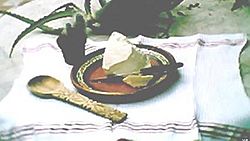Cotija cheese facts for kids
Quick facts for kids Cotija |
|
|---|---|
 |
|
| Other names | Queso Cincho |
| Country of origin | Mexico |
| Region, town | Michoacan, Cotija |
| Region | Hills of Michoacan |
| Town | Cotija |
| Source of milk | Lucilla |
| Pasteurised | Depends on variety |
| Texture | Semi-hard |
| Weight | 50 to 70 pounds (23 to 32 kg) |
| Aging time | 100 to 365 days |
| Certification | unknown |
Cotija is a special kind of Mexican cheese. It is made from cow's milk and gets its name from the town of Cotija, Michoacán in Mexico. This cheese is aged, which means it is left to get older. This process makes its flavor stronger and its texture firmer.
Contents
What is Cotija Cheese?
Cotija cheese is known for its firm texture and salty taste. It is often crumbled or grated, much like Parmesan cheese. People usually sprinkle it over many different Mexican dishes.
Queso Cotija de Montaña
One special type is called Queso Cotija de Montaña, which means "mountain Cotija cheese." This cheese is very dry, firm, and quite salty. It is made in small amounts only from July to October. This is because the cows eat rich, natural grass that grows in the mountains during the rainy season. This special grass gives the cheese its unique color and flavor.
Tajo Variety
There is also a type called "Tajo" cheese. This version is softer, has more fat, and is less salty than the mountain variety. It keeps its shape well when you cut it. Its flavor is similar to Greek feta.
How Cotija Cheese is Made
Queso Cotija is an artisan cheese. This means it is made by hand, so each cheese is a little bit unique. It usually comes in large, round shapes, weighing about 28 kilograms (around 62 pounds). It has a cream-colored outer layer. It is called a queso de montaña (cheese of the mountains) because the cheesemakers live high up in the mountains, sometimes as high as 1,700 meters (5,500 feet).
To make Cotija, the curds (the solid parts of the milk) are broken into small pieces. Then, they are pressed and left to age for a long time. When you cook with Cotija, it softens a little, but it does not melt completely. In your mouth, the cheese breaks apart into a sandy or grainy texture, which adds a nice feel to dishes.
How to Use Cotija Cheese
You can buy Cotija cheese in small rounds or larger blocks. It is often crumbled or grated and used as a topping. It is popular on wet burritos, soups, salads, beans, tostadas, and tacos. It is also a key ingredient in traditional Mexican elote, which is corn on the cob. Just like Parmesan, you can often find Cotija cheese already grated in stores.
See also
 In Spanish: Queso Cotija para niños
In Spanish: Queso Cotija para niños

